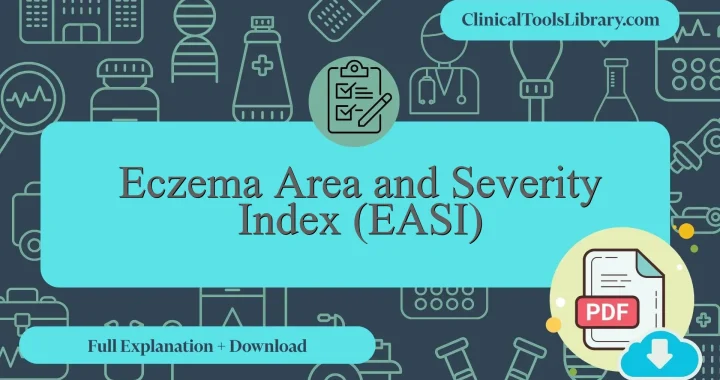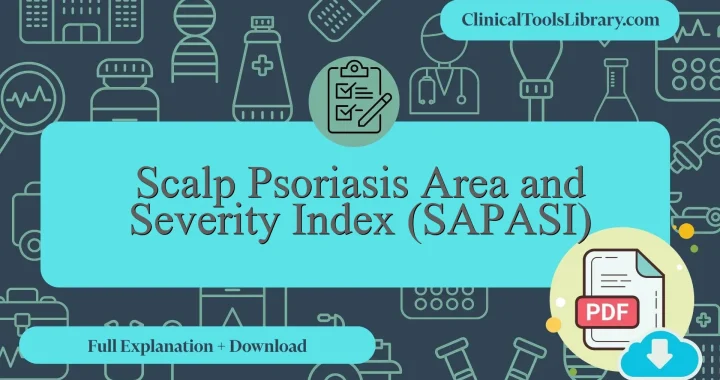In this article, we explain everything you need to know about the Childhood Atopic Dermatitis Impact Scale (CADI). We will cover the aspects it evaluates, the target population, a detailed step-by-step explanation, and how to interpret its results. Additionally, we will dive into the scientific evidence supporting this tool (diagnostic sensitivity and specificity) in clinical assessment. You will also find official and unofficial sources available for download in PDF format.
What does the Childhood Atopic Dermatitis Impact Scale (CADI) assess?
The Childhood Atopic Dermatitis Impact Scale (CADI) is a validated assessment tool designed to measure the psychosocial and physical effects of atopic dermatitis in pediatric patients. It evaluates the extent to which the disease influences daily activities, including sleep disturbances, emotional well-being, and social interactions. By capturing data on symptom severity and its impact on the child’s quality of life, CADI provides healthcare professionals with a comprehensive understanding of disease burden. Its main purpose is to facilitate targeted interventions by quantifying the impact of chronic inflammatory skin conditions specific to childhood, thereby guiding clinical management and treatment efficacy.
For which type of patients or populations is the Childhood Atopic Dermatitis Impact Scale (CADI) intended?
The Childhood Atopic Dermatitis Impact Scale (CADI) is primarily indicated for pediatric patients diagnosed with atopic dermatitis, especially those between the ages of 5 and 16 years. It serves as a valuable tool in assessing the subjective burden and quality of life impairments associated with this chronic inflammatory skin condition. The scale is most useful in outpatient dermatology and allergy clinics, where healthcare providers seek to quantify the psychosocial and functional impact of disease activity on children and their families. By capturing patient-reported outcomes related to sleep disturbance, itch severity, and emotional distress, CADI facilitates more targeted therapeutic decisions and longitudinal monitoring of treatment efficacy.
Step-by-Step Explanation of the Childhood Atopic Dermatitis Impact Scale (CADI)
The Childhood Atopic Dermatitis Impact Scale (CADI) consists of 5 items designed to assess the psychosocial impact of atopic dermatitis in children. Each item addresses specific domains such as itching, sleep disturbance, school absences, mood, and social interactions. Respondents select answers from a 4-point Likert scale ranging from “Not at all” to “A lot,” reflecting the frequency or severity of each issue over the past week. Administration involves guiding the child or caregiver to complete the questionnaire independently or with minimal assistance, ensuring clarity in understanding each question. Scores are then totaled to quantify the disease’s impact, facilitating clinical decisions and monitoring over time.
Downloadable PDF Resources for Childhood Atopic Dermatitis Impact Scale (CADI) in Original & English
Downloadable resources for the Childhood Atopic Dermatitis Impact Scale (CADI) are available below in both the original and English versions. These materials are provided in PDF format to facilitate ease of access and consistency in clinical and research settings. The CADI serves as a valuable tool in assessing the effects of atopic dermatitis on pediatric patients, enabling healthcare professionals to better understand and address the disease’s impact on quality of life.
How to interpret the results of the Childhood Atopic Dermatitis Impact Scale (CADI)?
The Childhood Atopic Dermatitis Impact Scale (CADI) evaluates the severity and impact of atopic dermatitis on a child’s quality of life by generating a cumulative score from responses to five items, each rated on a scale from 0 to 3, yielding a total score range of 0 to 15. Scores between 0 and 4 indicate minimal impact, 5 to 9 suggest moderate burden, while values ≥10 reflect a severe effect on daily activities and psychosocial well-being. For example, to calculate the total impact score, the formula is: Total CADI Score = Σ (Item Scores 1 to 5). In clinical practice, a higher CADI score necessitates a more aggressive management plan, including potential adjustments in treatment intensity or referral to specialized care, aiming to mitigate the dermatitis-related morbidity and improve patient outcomes.
What scientific evidence supports the Childhood Atopic Dermatitis Impact Scale (CADI) ?
The Childhood Atopic Dermatitis Impact Scale (CADI) test was developed in the early 1990s to quantitatively assess the quality of life impact of atopic dermatitis in pediatric populations. Validation studies have consistently demonstrated its reliability, internal consistency, and construct validity across diverse cohorts. The scale’s psychometric properties were examined through comparisons with established dermatological and pediatric quality of life instruments, confirming its sensitivity to clinical changes in disease severity. Longitudinal studies have further supported the CADI’s ability to detect treatment-related improvements, reinforcing its utility in both clinical practice and research settings focused on atopic dermatitis. This evidence underscores the CADI as a scientifically sound tool for evaluating the multidimensional burden of childhood eczema.
Diagnostic Accuracy: Sensitivity and Specificity of the Childhood Atopic Dermatitis Impact Scale (CADI)
The Childhood Atopic Dermatitis Impact Scale (CADI) has demonstrated a sensitivity ranging from approximately 78% to 85%, reflecting its capability to accurately identify children affected by atopic dermatitis. Its specificity values typically lie between 80% and 88%, indicating a strong performance in correctly excluding individuals without the condition. These metrics have been reported in validation studies assessing CADI’s effectiveness as a patient-reported outcome measure for capturing the burden of atopic dermatitis on pediatric populations. While minor variations exist depending on the sample and setting, the scale consistently provides reliable discrimination in clinical and research contexts.
Related Scales or Questionnaires
The Childhood Atopic Dermatitis Impact Scale (CADI) is often compared with instruments such as the Dermatitis Family Impact Questionnaire (DFI), the Infants’ Dermatitis Quality of Life Index (IDQOL), and the Children’s Dermatology Life Quality Index (CDLQI), all of which are explained and available for download on ClinicalToolsLibrary.com. The DFI offers insight into familial impact, capturing broader psychosocial effects but may be less specific to the patient’s individual experience. The IDQOL is tailored for younger children, providing detailed assessment of symptom severity, though it requires caregiver input, potentially introducing bias. The CDLQI is widely validated for pediatric dermatologic diseases beyond atopic dermatitis, enhancing generalizability but reducing disease-specific sensitivity. Each scale balances the trade-off between scope and specificity, with CADI uniquely emphasizing the direct impact on childhood atopic dermatitis patients themselves.




